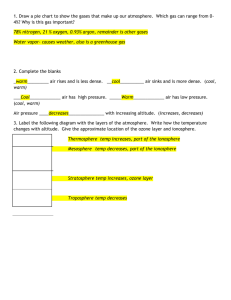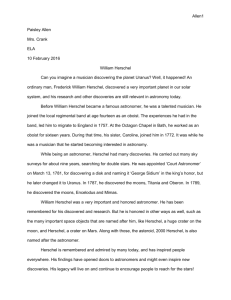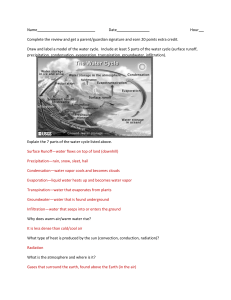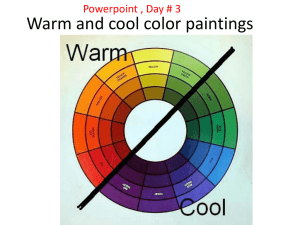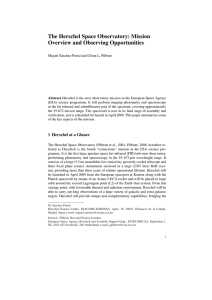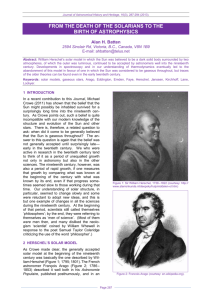KS2/3 - Project 5 – Keeping warm and keeping cool
advertisement
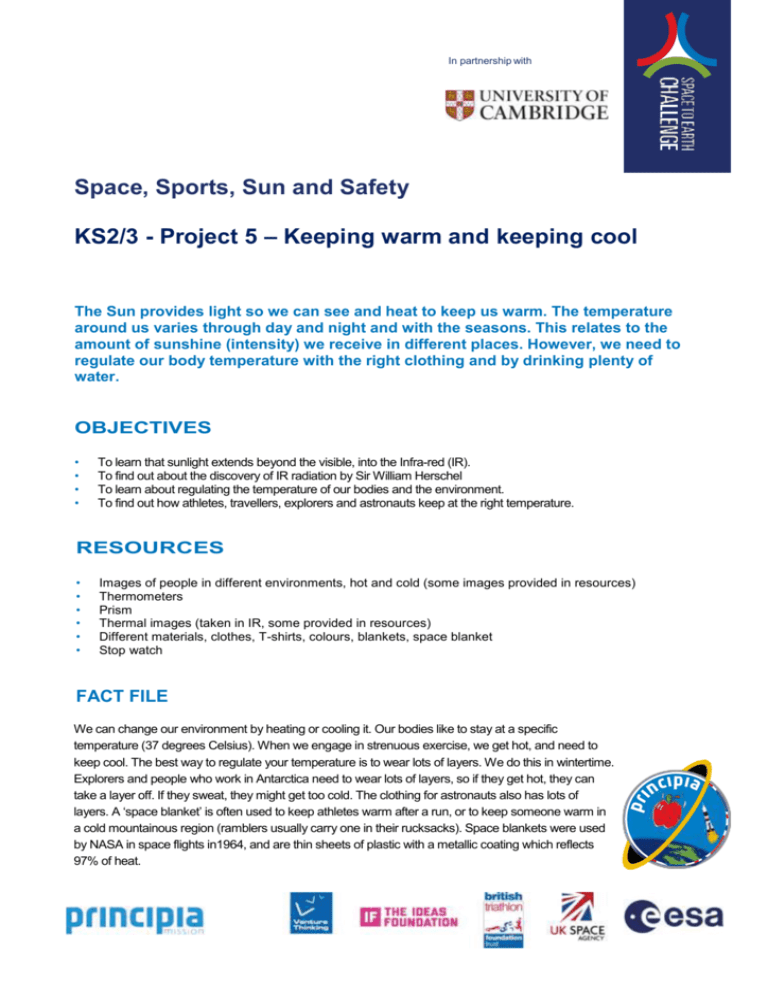
In partnership with Space, Sports, Sun and Safety KS2/3 - Project 5 – Keeping warm and keeping cool The Sun provides light so we can see and heat to keep us warm. The temperature around us varies through day and night and with the seasons. This relates to the amount of sunshine (intensity) we receive in different places. However, we need to regulate our body temperature with the right clothing and by drinking plenty of water. OBJECTIVES • • • • To learn that sunlight extends beyond the visible, into the Infra-red (IR). To find out about the discovery of IR radiation by Sir William Herschel To learn about regulating the temperature of our bodies and the environment. To find out how athletes, travellers, explorers and astronauts keep at the right temperature. RESOURCES • • • • • • Images of people in different environments, hot and cold (some images provided in resources) Thermometers Prism Thermal images (taken in IR, some provided in resources) Different materials, clothes, T-shirts, colours, blankets, space blanket Stop watch FACT FILE We can change our environment by heating or cooling it. Our bodies like to stay at a specific temperature (37 degrees Celsius). When we engage in strenuous exercise, we get hot, and need to keep cool. The best way to regulate your temperature is to wear lots of layers. We do this in wintertime. Explorers and people who work in Antarctica need to wear lots of layers, so if they get hot, they can take a layer off. If they sweat, they might get too cold. The clothing for astronauts also has lots of layers. A ‘space blanket’ is often used to keep athletes warm after a run, or to keep someone warm in a cold mountainous region (ramblers usually carry one in their rucksacks). Space blankets were used by NASA in space flights in1964, and are thin sheets of plastic with a metallic coating which reflects 97% of heat. In partnership with KS 2/3 Project 5 - Keeping Warm and Keeping Cool Athletes need to wear the proper gear to protect them from getting too hot, too cold or indeed injured. Bright orange or yellow safety jackets with reflective strips are worn by runners and cyclist, so they can easily be seen, for example by traffic. Helen Schell, an artist from Newcastle, has used these materials to make a fabulous dress for a Sun goddess (see resources). The Sun, Space and astronomy can be used in many ways to inspire artists. The Sun’s radiation extends beyond the red into the infra-red. We can’t see IR radiation, but we can measure it with a thermal or IR camera. Some of the Sun’s IR radiation is absorbed by the molecules in the Earth’s atmosphere, but most gets through to us. Our bodies regulate the core temperature by sweating, that is letting water evaporate through our skin. In order to keep cool, we need to drink lots of water. Water is very precious on the ISS, and some has to be re-cycled from urine. Samantha Cristoforetti, an ESA astronaut, said ‘On Earth, like on the ISS, clean drinking water is limited, let’s use it wisely’. Sir Frederick William Herschel (1738-1822) was born in Germany, but moved to the UK and lived in Slough. He became a well known astronomer and is most famous for the discovery of the planet Uranus, which he first called George after King George III. Herschel also discovered Infra-red radiation which he called ‘calorific rays’. Herschel directed sunlight through a glass prism to create a spectrum - the "rainbow" - and measured the temperature of each colour. Herschel decided to measure the temperature just beyond the red portion of the spectrum in a region with apparently no sunlight. To his surprise, he found that this region had the highest temperature of all. He was shocked with this result, and came to the conclusion that there must be an invisible form of light beyond the visible spectrum. ACTIVITY The aim of this activity is to encourage the students to come up with their own investigations into the intensity of the Sun’s radiation and how different materials respond differently. The aim is to explore how best we, athletes and astronauts can keep our bodies at the right temperatures. This means wearing the right clothes and making sure that we drink plenty of water. The students could: • Gather images from magazines and the web of different athletes, explorers, astronauts. Use images from the resources page if necessary. • Discuss what they are wearing and how their clothes regulate their body temperature. Discuss why the right clothes are needed. White clothing reflects the sunlight, black clothing absorbs it. Tennis players and cricketers for example wear white clothing. • Measure the temperature of each student and make a chart. • Take a glass of water and let it rest in different places, in the sunshine, shade, add ice or boiling water, then measure the temperature. • Use different materials to block the sunshine (fabrics, glass, plastic, sunglasses etc) and measure the temperature behind them. • What changes are found in the temperature for these different conditions? 2 In partnership with KS 2/3 Project 5 - Keeping Warm and Keeping Cool • Measure students’ pulse and temperatures before and after exercise (eg running), make a chart, varying the length of exercise time. • Explore images taken with a thermal camera (animals, houses etc), explain what a false colour image is, why some parts are hot, other parts cool. • How do athletes keep their bodies at just the right temperature? What fabrics are used? • Find out about life on Concordia Base, Antarctica, where temperatures get as low as -81 degrees Celsius (see link at bottom of page). Other questions to explore • What are the best materials to use in space? • How do penguins keep warm? How do camels store water? • Where is IR used (thermal cameras, night vision, remote TV controls)? • Design and make some T-shirts, space themed! • Design some ideal clothes for an athlete (runner), or explorer (Antarctic). • Why do hands and feet get cold first? • Design some accessories (eg with thermally responsive material). • Which athletes (swimmers, runners, skiers, cyclists etc) are most at risk from getting too hot or too cold? • Why do runners and cyclists wear bright clothing? • How do astronauts keep at the right body temperature, both inside and outside (on EVAs, ie space walks)? Do they ever feel too hot or cold? • Find out about how Sir William Herschel discovered IR radiation from the Sun • Use a prism and thermometer to try and reproduce Herschel’s discovery of IR radiation SAFETY NEVER LOOK DIRECTLY AT THE SUN. WEB LINKS Infrared images of penguins http://www.dailymail.co.uk/sciencetech/article-2288923/Infrared-images-reveal-cold-coats-help-emperorpenguins-warm.html Sir William Herschel discovers IR radiation from the Sun http://coolcosmos.ipac.caltech.edu/cosmic_classroom/classroom_activities/herschel_bio.html How do astronauts keep warm? http://science.howstuffworks.com/innovation/nasa-inventions/nasa-technology-keep-warm.htm 3 In partnership with KS 2/3 Project 5 - Keeping Warm and Keeping Cool Find out about life on Concordia Base, Antarctica, where temperatures get as low as -81 degrees Celsius! http://blogs.esa.int/concordia/2015/05/22/a-typical-winter-day-as-esa-research-medical-doctor/ Dehydration and sports http://news.bbc.co.uk/sport1/hi/health_and_fitness/4289412.stm Image: Université de Strasbourg and Centre National de la Recherche Scientifique (CNRS), Strasbourg, France - Penguins keep their bodies warm – images in resources in IR http://www.wired.com/2013/03/infrared-penguins/ http://phys.org/news/2013-03-emperor-penguins-outer-feathers-colder.html Recycling water in space and on Earth http://www.esa.int/Our_Activities/Human_Spaceflight/Research/Space_brings_fresh_water_to_Morocco 4
